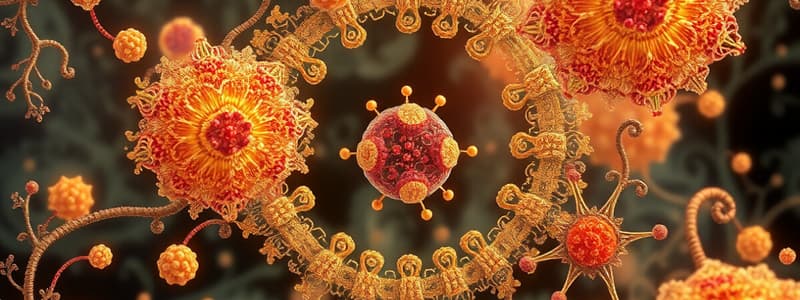Podcast
Questions and Answers
The majority of the atoms in a cell are found in the four elements: C, H, O, and N.
The majority of the atoms in a cell are found in the four elements: C, H, O, and N.
True (A)
Mineral compounds like Calcium carbonate (CaCO₃) always form in the aqueous environment inside a cell.
Mineral compounds like Calcium carbonate (CaCO₃) always form in the aqueous environment inside a cell.
False (B)
The majority of the cell's dry weight is made up of lipids.
The majority of the cell's dry weight is made up of lipids.
False (B)
All 20 naturally occurring amino acids have the same basic structure but differ by their side chains (R groups).
All 20 naturally occurring amino acids have the same basic structure but differ by their side chains (R groups).
Proteins are linear polymers of amino acids linked by peptide bonds, involving a hydrolysis reaction.
Proteins are linear polymers of amino acids linked by peptide bonds, involving a hydrolysis reaction.
The 3D structure of a protein determines its function, and this structure is primarily determined by its amino acid sequence.
The 3D structure of a protein determines its function, and this structure is primarily determined by its amino acid sequence.
All amino acids must be obtained from the diet, as the human body cannot synthesize them.
All amino acids must be obtained from the diet, as the human body cannot synthesize them.
The amount of water present in a cell is relatively constant across all cell types.
The amount of water present in a cell is relatively constant across all cell types.
Carbohydrates are an example of a macromolecule that is not essential for cellular processes.
Carbohydrates are an example of a macromolecule that is not essential for cellular processes.
The term ‘macromolecule’ refers to any molecule with large molecular mass, including inorganic molecules like salts.
The term ‘macromolecule’ refers to any molecule with large molecular mass, including inorganic molecules like salts.
Flashcards
Most abundant elements in cells
Most abundant elements in cells
C, H, O, and N represent about 96% of cell atoms.
Major type of organic molecule
Major type of organic molecule
Proteins, carbohydrates, lipids, and nucleic acids are organic molecules essential for life.
Role of water in cells
Role of water in cells
Water is essential for biological processes like solubility, hydrolysis, and thermal regulation.
Function of mineral salts
Function of mineral salts
Signup and view all the flashcards
Amino acids
Amino acids
Signup and view all the flashcards
Essential amino acids
Essential amino acids
Signup and view all the flashcards
Polypeptide
Polypeptide
Signup and view all the flashcards
Functions of proteins
Functions of proteins
Signup and view all the flashcards
Macromolecules
Macromolecules
Signup and view all the flashcards
Chemical properties of water
Chemical properties of water
Signup and view all the flashcards
Study Notes
Molecular Components of Cells
- This chapter details the chemical basis of life and properties of cell chemical molecules. Analysis at the atomic level reveals that only ~100 elements found on Earth are in living organisms.
- Four most abundant elements of living organisms are C, H, O, and N. These represent ~96% of atoms. P, S, Cl, Na, K, and Mg make up ~4%. Other trace elements (Cu, Zn, etc.) are present in very low concentrations.
- At the molecular level, cells comprise a wide range of molecules. These include carbohydrates, lipids, nucleic acids, proteins, and smaller quantities of other diverse organic compounds such as vitamins. Inorganic compounds like water and salts are also present.
- Water (H₂O) accounts for ~70% (average) of cell weight. It's a polar molecule forming hydrogen bonds. Water's properties are crucial for many biological processes like solubilization, hydrolysis, etc.
- Mineral salts, like sodium chloride, are dissolved in water forming ions with opposite charges. The balance of these ions are vital for phenomena like membrane permeability, cell division, etc.
- Various mineral compounds might be insoluble in water like calcium carbonate and calcium phosphate.
- Cells contain several organic compounds in the form of monomers and macromolecules. Proteins, polysaccharides, DNA, and RNA are macromolecules constructed from smaller monomers.
Organic Compounds
- Organic compounds exist as monomers or macromolecules.
- Proteins, which account for a significant portion (55-85%) of cell dry weight, are the most diverse macromolecule type. They're made from amino acid polymers. Diversity in amino acid sequences leads to a plethora of functions.
- Proteins' functions include structural support, catalysis (enzymes), transport, communication (hormones), and immune responses.
- Other organic compounds include lipids (energy storage, membranes). They offer diversity in biological functions and sequences.
- Carbohydrates are also essential, providing energy and structural components.
- Nucleic acids like DNA and RNA hold genetic information.
Proteins in Detail
- Proteins’ diversity results from varying amino acid sequences.
- Proteins form complex 3-D structures playing a crucial role in cell functions.
- Amino acids, the building blocks of proteins, are amphoteric and exhibit different properties based on their side chains (R).
- Twenty different amino acid types are commonly found in proteins. Eleven are categorized as essential because our bodies can't produce them.
- Polypeptides are amino acid chains linked by peptide bonds. These chains fold to form the proteins' functional structures. The structure directly correlates to its function.
Studying That Suits You
Use AI to generate personalized quizzes and flashcards to suit your learning preferences.




